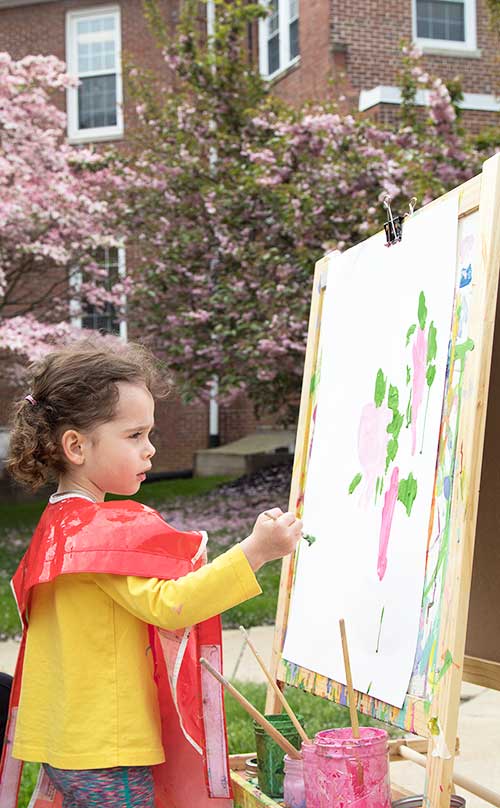Intentional Waiting in Preschool

Intentional Waiting in Preschool
Slowing Down in Daily Life Interactions Between Adults and Children
Spring has arrived at our Moorestown Preschool. The warm weather has filled us with wonder as we joyfully observe budding flowers and blossoming trees. There is new energy in our preschool classroom. It is a wonderful time of year.
In my last post, I wrote about the importance to step back and see the long-term growth of our preschool students. I would like to explore the idea of slowing down through a new lens: daily life and the interactions of adults and children.
With spring comes the realization that the school year is approaching an end, a feeling recognized by teachers, children, and families. There can be an urge to pick up the pace, to try to maximize dwindling time together by accomplishing “more.” When I feel that urge, I am reminded of this quotation by Loris Malaguzzi, the founder of the Reggio Emilia educational philosophy: “We need to know how to recognize a new presence, how to wait for the child. We often have to do it against our own rush to work in our own way.”
We Have Permission for Intentional Waiting in Preschool
Just the other day, our preschool class was walking across our campus. We took an unusual — although not unprecedented — route and came upon a grouping of trees called the Dogwood Grove. When the children saw the trees, they were immediately drawn to the dogwoods and cherry blossoms in full bloom. As the children decided to run through the trees, I was challenged to wait. What questions were being asked? What connections were growing? What is the value of spending time playing underneath the trees? Malaguzzi reminds us of the permission that we have for intentional waiting in preschool, to be with the trees, and to appreciate the moment.
As teachers and parents, it is important to examine what waiting looks like. We can find time and space to cultivate a relationship with the dogwood trees; however, there is more to the meaning of the word “wait.”
Intentional waiting in preschool is complex. As an adult, I must try to understand how the children see these trees. I must resist the urge to fill the time and space with information – my information. Malaguzzi says, “We don’t want to teach children something that they can learn by themselves. What we want to do is activate within children the desire and will and great pleasure that comes from being the authors of their own learning.”
Stopping to Smell the Dogwoods
Instead of imposing information, I look to instigate situations in which the children test and share ideas. Conversations together offer opportunity for sharing perspectives. In bringing an easel outside to paint the blossoms, children articulate their joy and interpretations of the blossoms, making them visible and interactive. The dogwoods have come to life. They exist not only in our visits, but also in the subsequent experiences which stem from our initial encounter.
Waiting is an active word, one which involves space and time, but also research and understanding. Intentional waiting in preschool supports layered thinking, and it emphasizes the importance of discovery. As the spring reaches towards summer and the threshold of year’s end nears, I am convinced that we can best spend our time together by stopping to smell the dogwoods.
Stay tuned next week for some examples and strategies about early childhood education from our Moorestown Preschool program.
Beginnings at MFS is the Moorestown Friends School Early Childhood Program (Preschool, Prekindergarten, and Kindergarten). The Beginnings Blog is intended as a helpful tool for parents and guardians of young children, examining important ways in which children find meaning, in their lives and in their education.
Author Garrett McVaugh is the Beginnings at MFS Half-Day Preschool Teacher. Along with his Teaching Assistant Pauline Williams, he guides some of the youngest MFS students through their first year of school. A graduate of Haverford College, Garrett has been an early childhood educator for over a decade. Prior to MFS, he was a teacher at Preschool of the Arts in Madison, WI. Prior to living in Wisconsin, Garrett spent eight years teaching at St. John’s Episcopal Preschool in Washington, DC.
Schedule a Visit with Us
Learn more by a visit in person and meet with one of our excellent Early Childhood Program teachers.
